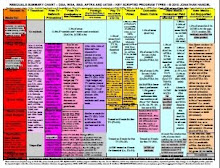Last week I conducted interviews with David Jolliffe and Anne-Marie Johnson, leaders of the dominant Membership First faction of the SAG National (and Hollywood) Board, and Ned Vaughn, leader of Unite for Strength, the challengers. An actor-like congeniality reigned, including flirtatiousness in Johnson’s case. Clear and convincing answers, however, were in short supply.
Regular readers of my posts know that I’ve been highly critical of Membership First for dragging the industry through a work stoppage in pursuit of goals that it doesn’t have the leverage to obtain because SAG doesn’t appear to be able to achieve the 75% vote threshold necessary to authorize a strike. As I’ve also said, if SAG were willing to accept the studios’ new media framework, it would more than likely be able to negotiate some of the other issues that matter.
I’ve also criticized SAG (i.e., MF) for all but driving AFTRA out the door, a job which AFTRA finished, severing a 27-year old joint negotiating strategy that presented a more or less united front at the bargaining table. The studios, as a result of the breakdown of this arrangement – called “Phase 1,” in the optimistic view that it was the first step of a merger – have been able to play one union off against the other in the current round of negotiations. AFTRA has become a much more effective competitor to SAG than it ever was.
My feelings about Membership First remain largely unchanged after the interview. Jolliffe and Johnson suggested only that educating the members would lead to the requisite level of support. This may be true, but why that wasn’t done over the last three years (since the time MF took power) is a mystery. That approach would have led to negotiations with leverage more clearly established.
The first step of that education campaign turns out to be a nine page letter to the members summarizing the deal on the table. That letter is apparently in the mails now, or shortly, accompanied by a postcard soliciting members’ reaction to the deal. If the letter is fairly one-sided, which seems likely, this mailing will constitute what politicians call a “push poll”: a poll designed to influence opinion, rather than simply record it. It will be interesting to see if SAG releases the results – and the vote totals, i.e., turnout.
The strategy may yet work, which could lead to a deal more favorable to SAG than I was expecting. We’ll see. But if that is the case, there’s still the difficult problem of AFTRA, on the TV side, at least. A better SAG deal means the AFTRA deal is less expensive to producers, and that means they’re likely to choose AFTRA over SAG for new shows, in network as well as basic cable (where this has already been happening for over a year, to SAG’s anger and dismay).
What’s SAG to do? The striking thing about Jolliffe and Johnson’s responses in my interviews is that they have no answer, other than to simply wish AFTRA away and declare that SAG is the actors union. Spending Labor Day at the beach is a fine thing, but sticking one’s head in the sand isn’t so effective.
Then there was the vagueness. For instance, are negotiations currently in progress? SAG has said yes, and the studios say no. Jolliffe’s answer: “only Alan and Doug” – SAG’s president and National Executive Director – know the answer. Considering that Jolliffe has been pulling many of the strings for the last several years, that’s more than disingenuous. How to repair the relationship between SAG’s
For obvious reasons, I had hoped that Unite for Strength would present an attractive alternative to MF marked by a realistic approach to negotiation that would lead to actual gains for the guild. I expected a forceful explanation of how UFS (also referred to as U4S) would approach the task.
No such luck. Instead, Vaughn offered vague answers to specific questions. What does Vaughn want on the issues? Hard to know – he wouldn’t say. Would UFS fire the National Executive Director? Reconstitute the negotiating committee? I don’t know. Lots of hemming and hawing, followed finally by some hint that these options might be on the table, but no clear answer.
That’s not the breath of fresh air that I’d been hoping for. Indeed, oddly, the UFS literature pieces I’ve seen don’t even address the issue of how UFS would conduct bargaining with the studio alliance (the AMPTP). SAG’s in the middle of the worst theatrical and television contract negotiations in two decades – thanks largely to MF – and UFS won’t even express an opinion on what to do? That’s only a relatively small improvement over the people who got SAG there in the first place.
UFS instead focuses on merger with AFTRA, which it strongly supports. That to me is a longer term goal that ignores the matter on the table, as well as the commercials contract that was to be negotiated shortly. It’s been postponed six months but is still more immediate than any merger.
In any case, merger presents a dilemma: any unification is going to have to give the former AFTRA board some kind of equal say in policies and decisions, yet SAG will probably insist on proportionate representation, which would swamp AFTRA. Why would AFTRA accept this – and why would SAG accept the alternative?
Another matter is the name of the merged union, which clearly would have to be neither “SAG” nor “AFTRA.” This is a sensitive matter, since SAG’s is clearly the stronger brand name, yet AFTRA can scarcely be expected to accept a name that suggests an acquisition rather than a merger. It seems to me that “SAG-AFTRA” might be a logical choice, though the almost consonant-less, and thus perhaps wussy-sounding “AIMA” was the proposal several years ago when merger was last attempted. (That attempt garnered a majority of AFTRA voters, something that’s unlikely today, and 58% of SAG voters, just shy of the requisite 60%.) In any case, Vaughn’s answer, that “Uncle Joe's Actors Union” would be fine if need be, was cute, flippant, but also insensitive to decades-long SAG members.
Add to all of this the poisoned well from which both unions now draw their water, and it’s hard to see how merger would be accomplished. Vaughn seemed to wish away these difficulties with AFTRA, just as Jolliffe and Johnson would wish away AFTRA itself. Vaughn suggested forming an umbrella union for all entertainment workers. That would bring real strength to the table, just as all studios, and effectively all producers as well, are united at the table. It’s the right thing to strive for in the long, long term. But, at least for now, it seems an unachievable goal. Unity between SAG, AFTRA, Equity, the WGA, the DGA and the IA (IATSE) is almost unimaginable.
Then there’s the matter of qualified voting, aka affected member voting or affected voting. Vaughn and some members of his slate, before they were a slate, ill-advisedly pushed for this in the spring (“ill-advisedly” because it’d be political suicide for a Board member to support a proposal that would disenfranchise many SAG members). When MF successfully defeated the measure by exiling to a Board committee, the proponents vowed to keep fighting. But after they decided to run for the Board, they vowed not to support qualified voting. A flip-flop? You be the judge. Surprisingly, their old website supporting qualified voting is still up and accepting names of supporters. Vaughn dismissed the site as a “historical document,” but the fact remains that the site's still up and his name is still on it. That’s a gaffe.
Finally, let’s look at
———
Several hundred people have viewed the interviews live or in the archives. Check out the videos if you haven’t. Reaction has been burning up the SAG-ecology blogosphere: take a look at Blog Stage (and here), IMDB (and here, here, here and here), Deadline Hollywood Daily, SAG Actor bulletin board, SAGwatch blog (and here, here, here and here), and SAG Watchdog. And watch for my interviews this week with the independent candidates from

